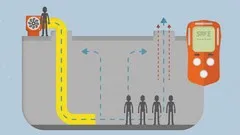
Occupational Safety and Health Tool Box Talks 
Discover the Occupational Safety and Health Tool Box Talks course, featuring short, informative videos designed to enhance your skills as a safety professional. With new videos added monthly, this course is perfect for toolbox talks or for those seeking continuous development. Learn about critical health and safety principles, such as hazard identification, risk assessments, and personal protective equipment. Gain knowledge on incident investigation terminology and how to read dangerous goods material safety data sheets. Please note that learners should meet specific requirements before proceeding with this program. Don't miss out on this opportunity to broaden your skills and ensure a safer work environment. ▼
ADVERTISEMENT
Course Feature
![]() Cost:
Cost:
Free
![]() Provider:
Provider:
Udemy
![]() Certificate:
Certificate:
No Information
![]() Language:
Language:
English
![]() Start Date:
Start Date:
2021-11-17
Course Overview
❗The content presented here is sourced directly from Udemy platform. For comprehensive course details, including enrollment information, simply click on the 'Go to class' link on our website.
Updated in [September 27th, 2023]
What does this course tell?
(Please note that the following overview content is from the original platform)Short 15 to 30 minutes videos for you or your team to use during toolbox talks or if you would like to provide yourself with a platform for continuous development to broaden your skills as a safety professional new videos added every monthToolbox talk are a great way to reinforce safety basics focus on high-risk scenarios and to inform workers about changes to the jobsite and working conditions that may have occurred since their last shift Be sure to discuss cover any accidents or injuries that have occurred and how they could have been preventedThroughout these videos you will learn and be reminded of some critical basic Health and Safety Principles like:Understanding the Occupational Health and Safety Act (No 85 of 1993)Personal protective equipment and trainingHazard identification and risk assessmentsManage work at elevated positionsTerminology used in incident investigationHow to know read and understand each dangerous goods material safety data sheetDescribe the requirements to apply a confined space entryPlease note that before a learner proceeds on this learning programme he&she should meet the following requirements as perthe relevant unit standard (please refer next page):Communication at NQF Level 3Mathematical Literacy at NQF Level 3Unit Standard: Provide risk based primary emergency care& first aid in the work place: SAQA ID 120496Unit Standard: Respond to implement and manage emergencies according to an emergency action plan in a workplace: SAQA ID: 120329Unit Standard: Demonstrate knowledge pertaining to fires in working places; SAQ ID 120331
We considered the value of this course from many aspects, and finally summarized it for you from two aspects: skills and knowledge, and the people who benefit from it:
(Please note that our content is optimized through artificial intelligence tools and carefully reviewed by our editorial staff.)
What skills and knowledge will you acquire during this course?
During this course, learners will acquire the following skills and knowledge:
1. Understanding of the Occupational Health and Safety Act (No 85 of 1993): Learners will gain knowledge about the legislation that governs occupational health and safety in their country.
2. Personal protective equipment and training: Learners will learn about the importance of using personal protective equipment (PPE) and how to properly select, use, and maintain it. They will also understand the importance of training workers on the proper use of PPE.
3. Hazard identification and risk assessments: Learners will develop skills in identifying hazards in the workplace and conducting risk assessments to determine the level of risk associated with each hazard. They will also learn how to implement control measures to mitigate these risks.
4. Managing work at elevated positions: Learners will acquire knowledge on how to safely work at elevated positions, such as scaffolding or ladders. They will learn about the necessary precautions and safety measures to prevent falls and other accidents.
5. Terminology used in incident investigation: Learners will become familiar with the terminology and concepts used in incident investigation. They will learn how to properly document and report incidents, as well as how to analyze the root causes to prevent future occurrences.
6. Reading and understanding dangerous goods material safety data sheets: Learners will gain the ability to read and understand the information provided in material safety data sheets (MSDS) for dangerous goods. They will learn how to interpret the hazards associated with these substances and how to handle them safely.
7. Requirements for confined space entry: Learners will learn about the requirements and procedures for entering confined spaces safely. They will understand the potential hazards and the necessary precautions to protect workers in these environments.
It is important to note that learners should meet certain requirements, such as communication and mathematical literacy skills, as well as specific unit standards related to emergency care, first aid, and emergency management, before proceeding with this learning program.
Who will benefit from this course?
This course will benefit safety professionals and individuals who are responsible for occupational safety and health in their workplace. It is also suitable for team leaders or supervisors who conduct toolbox talks or safety meetings with their teams.
Specific professions that will benefit from this course include:
1. Safety Professionals: This course will provide safety professionals with a platform for continuous development and skill enhancement. They can use the videos during toolbox talks to reinforce safety basics, discuss high-risk scenarios, and inform workers about changes in the jobsite and working conditions.
2. Team Leaders/Supervisors: Team leaders or supervisors who conduct toolbox talks will find this course valuable. The videos can be used as a resource to educate their team members about important health and safety principles, such as understanding the Occupational Health and Safety Act, personal protective equipment, hazard identification, and risk assessments.
3. Workers in High-Risk Industries: Workers in industries with high-risk scenarios, such as construction, manufacturing, or mining, will benefit from this course. The videos will help them understand and apply safety measures to prevent accidents and injuries in their workplace.
4. Emergency Response Personnel: Individuals who are responsible for providing primary emergency care and first aid in the workplace, responding to emergencies, and managing emergencies according to an emergency action plan will find this course useful. The course covers unit standards related to emergency response and fire safety.
It is important to note that learners should meet the specific requirements mentioned in the relevant unit standards before proceeding with this learning program. These requirements include communication skills, mathematical literacy, and knowledge of emergency response procedures.
Course Syllabus
Introduction
Executive Legal Liability
Hazard Identification and risk Assessment
Dangerous Goods Handling
Safety Supervisor
Course Provider

Provider Udemy's Stats at AZClass
Discussion and Reviews
0.0 (Based on 0 reviews)
Explore Similar Online Courses

Management of WSH Incidents

Legal Compliance of WSH Management System

Python for Informatics: Exploring Information

Social Network Analysis

Introduction to Systematic Review and Meta-Analysis

The Analytics Edge

DCO042 - Python For Informatics

Causal Diagrams: Draw Your Assumptions Before Your Conclusions

Whole genome sequencing of bacterial genomes - tools and applications

Measures & Schools Response to COVID-19 Pandemic

Entering Enclosed Spaces aboard Ships Safety Awareness


Start your review of Occupational Safety and Health Tool Box Talks